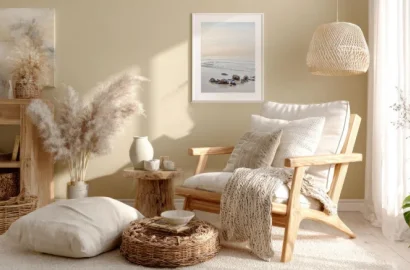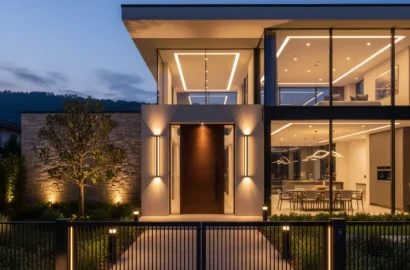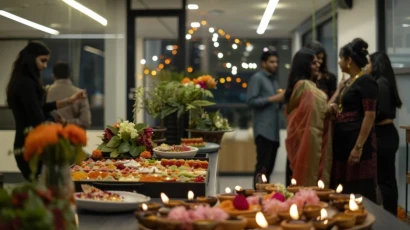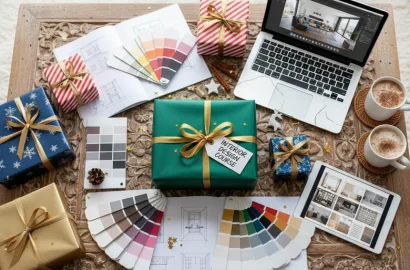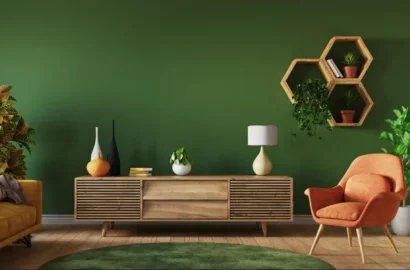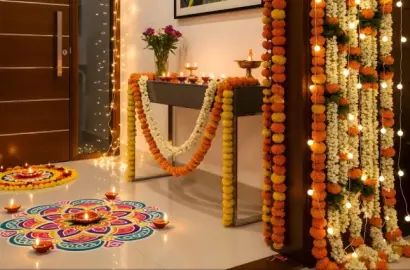Learn everything there is to know about interior design – from its styles and principles to career opportunities and benefits. In this guide, you’ll also find practical steps for launching your interior designer career!
Are you curious about where a career in interior design might take you? If so, then look no further!
In this ultimate guide to interior design, we’ll be running through everything you need to know about this creative and exciting field, rounding off with the concrete steps to take if you’re interested in launching an interior design career.
Here’s a clickable list of everything we’ll be covering in this article!
- 1) What is interior design?
- 2) What’s the main purpose of interior design?
- 3) Why is interior design important?
- 4) What are the major interior design styles?
- 5) What are the key principles of interior design?
- 6) Key interior design software
- 7) What does an interior designer do?
- 8) Interior design jobs, salaries, and careers
- 9) What’s the difference between interior design and interior decorating?
- 10) How to become an interior designer
- 11) Conclusion
Ready to learn? Then let’s get started!
What is interior design?
Interior design refers to the enhancement of the interior of a building or room in order to create a more aesthetically pleasing, functional, accessible, and safe space for those who use or inhabit it. While many of us might think of interior design as simply choosing furniture or arranging the lighting, the profession includes many practical and interpersonal elements such as construction organization, extensive research, and relationship building.
A brief history of interior design
Interior design can be traced as far back as ancient civilizations, where decoration and simple furnishings were used to create more comfortable living areas. Evidence suggests the Egyptians, Greeks, and Romans all embraced a certain amount of interior decoration, using richly coloured fabrics and elaborate mosaics to decorate their homes and recreational spaces. Interior design evolved further during the Renaissance period when internal decoration became a signifier of wealth, decadence, and luxury. This desire to use furnishings and interior design to showcase status frequently involved the adoption of more expensive materials for those who could afford it.
By the 19th and 20th centuries, interior design had–along with the rise of industrialization–evolved to focus more on functionality and the modern ideas of minimalism and simplicity. Today, trends in interior design tend to focus on sustainability in response to the climate change crisis, and creating interiors which can promote positive well-being as increasing numbers of people choose to work from home.
What’s the main purpose of interior design?
While we might think of interior design as being purely an aesthetic endeavour, its main purpose is actually more nuanced. Although the visual aesthetic of a space is a very important element of an interior designer’s work, it has to work in harmony with the accessibility and functionality of a space. Ultimately, an interior designer must ensure that everyone who uses the space can do so in a safe way, while enabling them to meet all of their immediate needs.
Why is interior design important?
While it’s easy to say that interior design makes a space more visually appealing, the practice actually brings about a range of other benefits that should not be underestimated. Below are some of the main reasons why interior design is so highly valued.
Maximizes the amount of available space
Interior design enables us to make the most of the space we have. In smaller spaces, an interior designer will opt for furniture that uses up minimal floor space, such as floating shelves, tables and chairs with narrow legs, and couches that are shallow-depth. Vertical spaces will also be taken advantage of with hanging plants and built-in bookshelves. Stowable and multipurpose furniture also helps create more space, while mirrors and skylights can increase the amount of natural light coming into a room, making a room appear larger and feel more spacious.
Enhances well-being
Improving the quality of life and well-being of those occupying a space is a hugely important function of interior design. By combining specific fabrics, materials, colours, and natural and artificial lights, an interior designer can enhance the atmosphere in a room and boost the moods of its inhabitants, turning a house into a home, or an office into an exciting, energetic, and productive workspace. An interior designer will seek to inject personality and personal preferences into a space, making it a true reflection of those who live or work there.
Increases property value
Working on the design of an interior can bring about an increase in the value of your property. This is not only true when major renovations, such as an extension, have taken place; minor interior design and decoration changes such as freshly painted walls, or even rearranging or modernizing the furniture in a room, can increase the interest prospective buyers show.
Can aid a sustainable lifestyle
The interior design of buildings and homes is increasingly reflecting a need for sustainable living as it mirrors sustainable consumer trends and behaviour in the face of a changing climate. An interior designer can design for energy efficiency, bringing in elements such as carpets and drapes for room insulation and heat retention, and using paint colours and reflective surfaces which reflect light to save on artificial lighting. An interior designer will also have knowledge of which materials, such as organic and renewable materials, create the lowest environmental impact, and which labels, standards, and certifications on those materials ensure they come from legitimate sources. Waste reduction is also a consideration in interior design, with interior designers opting to upcycle or reuse products rather than simply discard items that are no longer deemed “in fashion.” The longevity and flexibility of products also play a role in interior design today, as consumers seek to use items for as long as possible in order to impact the planet less. When combined, these changes to interior spaces contribute to and support an individual’s sustainable lifestyle or a businesses’ climate impact.
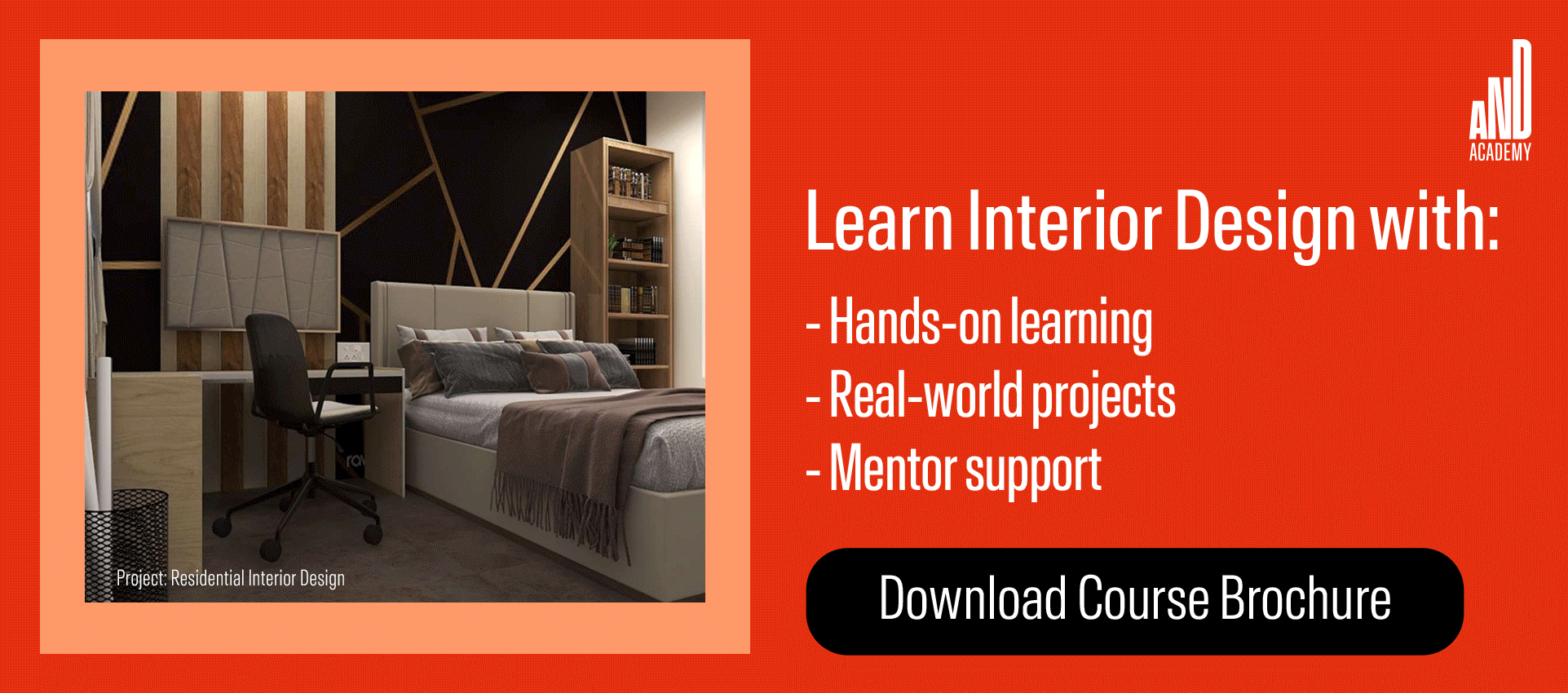
What are the major interior design styles?
Interior design isn’t limited to one style or aesthetic; in fact, many designers combine styles and preferences to create unique and eye-catching interiors. There are, however, four major interior design styles that all interior designers are familiar with and that provide the foundation on which other styles and designs can develop. Here’s a rundown of them:
Traditional
Influenced by the styles of 18th and 19th Century European homes, traditional interior design is still a popular choice today. In contrast to more modern designs, traditionally-styled homes provide a reassuring, timeless backdrop to family living that is both stylish and well put together without being cluttered or overly decorative. Neutral colour schemes, landscape paintings to decorate the walls, and carved-wood furniture are popular in traditionally-designed homes or buildings.
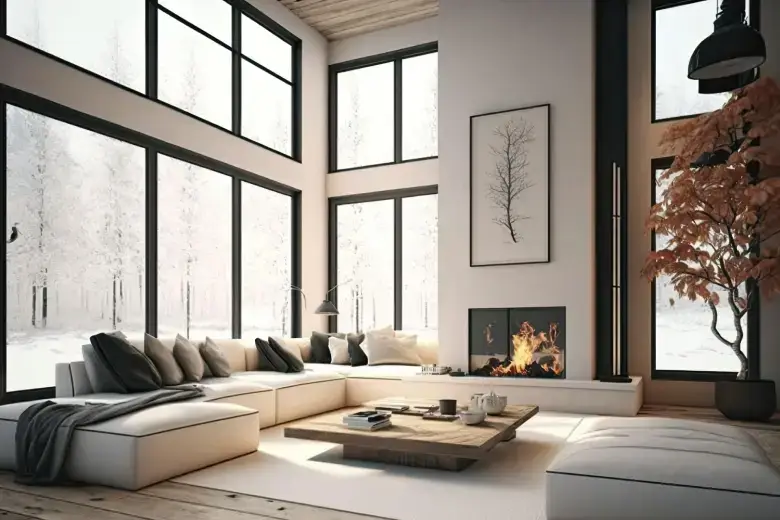
Modern
Grown out of the modern art movement and gaining traction in the early 20th Century, modern interior design styles are typically characterized by a monochrome colour palette, natural light, clean lines, and a minimalist approach to furniture and layout. Modern design hails from German “Bauhaus” and Scandinavian interiors, which promote functionality and experiments with form. Floor-to-ceiling windows, open-plan living areas, and stark, simply-shaped furniture are typical of this design style.
Minimalist
Minimalist interiors don’t stray too far from the modern approach to interior design. The style concerns itself with stripping back non-essential pieces of furniture or decoration and leaving only the most necessary items. This promotes an uncluttered and spacious aesthetic. Again open plan living spaces and clean lines are important here, as is a monochromatic color palette. The key difference between modern design and minimalist design is that while modern design still leaves room for spontaneous decoration or creativity, minimalist design insists upon the installation or adoption of furniture or items which serve a specific, and needed, purpose.
Bohemian
As the name implies, the bohemian style is the most creative, spontaneous, and unconventional of the interior design styles. Playful styles and patterns are thrown together, with contrasting textures, woods, metals, and colors. Elements of different cultures and artistic expressions are found in the same rooms and warm earthy colors are embraced. Secondhand and vintage pieces are typically found in bohemian homes, as are floor pillows, vibrant rugs, ambient lighting, and every kind of hanging plant.
What are the key principles of interior design?
As we have seen, interior design is about much more than just making a room look nice. In order to meet all of a client’s unique needs–aesthetic, personal, and practical–and bring about a sense of well-being, an interior designer will also work with the following principles when designing a space.
Balance
Balance refers to the distribution of objects and decorations as evenly as possible, giving the impression of equilibrium across a space or room. Balance is concerned with the “visual weight” an inhabitant of the room experiences upon entering. To achieve balance, attention should be paid to where furniture and objects are placed within a space. Elements to consider when ensuring the balance of space include symmetricity, asymmetricity, and radial balance.
Unity
Unity refers to the idea of unifying all of the objects with the room, rather than alienating them. This could be achieved throughout a home by having a similar style flowing between each room, creating a unifying feeling as one goes from room to room, and within the rooms themselves through the selection of harmonious furniture and decoration choices that complement the space.
Rhythm
In interior design, rhythm refers to decorative repetition throughout a living or work space, such as similar finishes or styles of furniture. These elements should be both eye-catching and consistent throughout the interior, with decorative pieces in one room mirrored in other rooms.
Proportion and Scale
This principle of proportion and scale centres around the idea of how the furniture and decorative elements of an interior fit into their allocated space. Usually, the size of the space itself will determine what fits into it and what looks good; for example, high ceilings and large floor spaces work well with larger pieces of furniture and heavier decoration. Small spaces require more delicate pieces and lighter pieces of furniture. Proportion looks at how these elements all work together while taking into account colours, textures, and patterns, too.
Emphasis
The idea behind the emphasis principle is to create a focal point to a room that draws in the eye. An accent wall in a living space, an ornate mantelpiece above the fireplace in a drawing room, or a striking piece of art in the kitchen, are all great examples of how to garner the attention of visitors, and create a central point around which the rest of the room can be designed.
Contrast
Using polar opposite design styles, contrasting textures, and monochromatic colour palettes, contrast is a powerful way to create a striking design statement. Examples of contrasting pairs that might be used include dark and light spaces, natural and synthetic elements or materials, and soft forms and hard edges.
Details
Attention to detail is a key facet of successful interior design. Elements such as door or cupboard handles, and accessories in the kitchen, bathroom, or conservatory can be used to complement, enhance, or lift up the decor of the entire space.
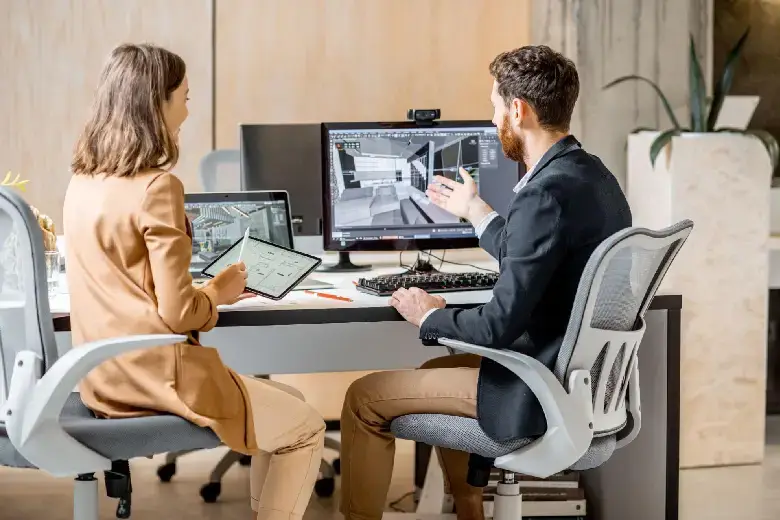
Key interior design software
Interior design software has made interior designing more simple over the years. The primary goal of most interior design software programs is to enable the planning and designing of the interiors of homes and offices, with some focusing on particular rooms and others that can be extended to the whole house. Hand sketching ideas has become a thing of the past, as technology, such as 2D and 3D modeling, has enabled the creation of realistic imagery to demonstrate different concepts. Planner5D, Autodesk, SketchUp, and Homestyler are popular visualization and planning tools for interior decoration and design. Many of these software also provide collaboration assistance, visualization, floor planning guides, and 2D and 3D modeling, while some can even estimate material costs.
What does an interior designer do?
If you’re considering getting into the field of interior design, it’s important to have a clear idea of what might be expected from you in this creative yet demanding role. Let’s walk through what working in the field looks like in practice.
Job description
An interior designer works to create safe, attractive, and functional indoor spaces for work, living, and leisure. Through the selection of furniture, colour schemes, lighting, and decoration, they seek to create a harmonious atmosphere that optimizes the space while matching the specific requirements of the client and reflecting the individual’s unique personality and preferences.
Typical requirements found in the interior designer job description include:
- Take ownership of a design project from initial ideation to completion
- Identify and implement project requirements and timeline
- Translate customer preferences and requirements into a plan of action
- Align project fees and outgoing costs with the available budget
- Research and select appropriate materials and pieces
- Keep a close eye on how work is progressing on the project
- Collaborate with architects, construction workers, other designers, and decorators
- Conduct regular research on industry developments and best practices
Key skills
Creativity and flair
When one thinks of an interior designer, one thinks of someone with a natural sense of creativity and flair and it’s certainly true that an appreciation of shape, colour, and form are essential to this role. An interior designer will be called upon to select complementary patterns, textiles, and colours to create the desired look for the client while taking into account the available space and architectural details.
Attention to detail
An interior designer will need to pay close attention to detail in order to choose the decorative, personal, and functional pieces which best reflect the client’s taste. While they may seem insignificant to a layman, small details such as kitchen accessories, mirrors, and doorknobs contribute to the overall look of a space, and, when combined correctly with larger statement pieces, fabrics, and colour schemes, create a unique and personalised interior.
Knowledge of current trends
Knowledge of current trends helps a designer remain relevant in the field and be able to incorporate the most up-to-date concepts into their interiors. Knowledge of what’s currently trending also helps a designer stay up to date with advances in sustainable processes and products, and get a feel for the looks that users want to recreate in their homes.
Organization and communication skills
Organization and communication skills are also necessary in this role. The interior designer will need to communicate their vision in layman’s terms while still inspiring the client with their ideas. Organization skills come to the fore in the planning of project timelines and budgets, essential for managing client expectations and delivering on the agreed outcome.
Knowledge of sustainable practices
With the impact of climate change becoming ever more apparent, knowledge of sustainable practices, materials, and technologies is now paramount to the practice of interior design and no longer just a ‘nice to have’ but an essential skill in the field. Clients, both individuals and businesses, want to create sustainable environments that have a minimal negative impact on the climate.
Sketching
While much of the sketching and ideation work of the interior designer can be done using digital tools these days, the ability to sketch out preliminary concepts by hand is still a great skill to have in this role. This is particularly useful when the designer needs to quickly visualize an idea during a conversation about what the client is looking for in the design. Experience with the latest sketching and collaboration software will also be needed in order to create, share, and work on design ideas in more detail once the initial ideas have been agreed upon.
Project types
Interior designers work both with individuals on the designs of their homes and living spaces, and with business clients from a range of industries on their work areas and the spaces within which they receive clients, patients, students, and customers. Let’s take a look at how the work of residential and commercial interior designers differs.
Residential
In residential interior design, an interior designer is focused on enhancing and decorating the space where their client or clients live. In collaboration with the inhabitant of the space, the designer will seek to comprehend and incorporate the individual’s personal style, preferences, behaviour, and lifestyle into the overall design of their home. One will need to take into account if the individual has children, accessibility issues, pets, and any other specific needs or preferences, as all of these would impact the design.
Key elements of residential interior design include bringing into the design the client’s personal belongings and sentimental items, ensuring the space is comfortable, and that the ambience of each room brings about a sense of well-being, all of this while retaining optimal functionality.
Due to the personal nature of residential interior design, building and maintaining an excellent relationship with the client will be essential for the interior designer to understand what makes them tick and what they will be looking for from a design.
Commercial
Such interior design is concerned with the design and decoration of commercial spaces. In these environments, understanding the user experience of the space plays a central role. Depending on the sector or industry, the interior designer will need to research how the space is perceived by those using it, what their needs are, and what might improve their experience in and of the commercial space being designed. Elements that need to be considered alongside more general interior design principles include building navigation, signage, entrances and exits, accessibility, services offered, storage, natural and artificial lighting, and acoustics, to name just a few. Commercial interior designers will work for a variety of clients such as retailers, healthcare providers, corporate businesses, and those in the hospitality sector, for example, hotels, bars, and cafes. With each of these industries catering to very different needs and customer demographics, an interior designer would need to prioritize user research in order to fully understand the requirements of the space and meet the specific needs of those who use it.
Learn More: Types of Interior Design (with examples) You Should Know That

Interior design jobs, salaries & careers
Demand for interior designers is growing. On a global level, those embarking on a career in the field can expect to see a compound annual growth rate of 6.4% in the period up to 2032, with the market reaching a value of $213.7 billion. In India, the picture is even more positive. In 2022, the Indian interior design market was worth $28.6 billion, with finance experts predicting that it would grow to $51.4 billion by 2028, exhibiting a compound annual growth rate of an impressive 10.3% between 2023 and 2028.
Salaries for interior designers vary from country to country. While the average salary for an interior designer in the US is currently $64,085 per year, in India the same role commands ₹ 3.0 Lakhs per year . In the UK, an interior designer in 2023 might expect to take home £37,693 annually, in Germany that goes up to €58,550.
With so many interior designers choosing to work freelance, it’s important to bear in mind that salaries will vary again depending on experience, network, how often you choose to work, and location. When considering this career choice, you’ll also need to think about the cost of living in your area and average salaries across the board to get some perspective on how well you will fare financially in this position.
While interior design is certainly the most common career choice for those with the skills and experience we’ve described in this article, there are numerous other careers that those interested in interior design might want to branch into or specialize in. Here are just a handful of roles that an interior designer could potentially fill:
- Kitchen designer
- Corporate designer
- Furniture arranger
- Home lighting adviser
- Interior decorator
What’s the difference between interior design and interior decorating?
With so much confusion still surrounding the requirements and responsibilities of these two similar-sounding practices, let’s get some clarity on what the similarities and differences are between interior design and interior decorating.
Definition of interior decorating
Interior decorating is when a room or space is adorned to make it aesthetically and visually pleasing. This is achieved through the use of wall colours, fabrics, furniture, and other decorative objects and elements.
Similarities and differences between the two areas
While the two disciplines certainly overlap, it’s important to note that interior design and interior decorating are not the same practice. As we have seen, interior decoration is primarily concerned with the visual and aesthetic considerations of a space and how to make it more beautiful to those who inhabit it. Although interior design seeks to address the same concerns, it approaches them alongside seeking to understand the needs of individuals who live or work there. It does this by incorporating key principles and following a systematic methodology that prioritizes functionality, accessibility, safety, well-being, and aesthetic considerations. Every design by an interior designer should accurately mirror and address the specific needs of the client.
How to become an interior designer
If you’re feeling inspired to explore a career in interior design, then you’ll want to know where to get the training and experience needed to hone your skills and land your first position in the field. Well, look no further: here’s our checklist for launching your interior design career!
Learn the skills via a course or a degree
As a profession, interior design is a career for which you’ll need to onboard the relevant knowledge, skills, and experience. You can study interior design as a degree course, or choose to learn via a shorter online or offline certificate course through an accredited institution such as an evening college or online school. A degree is typically around 3 years and will consist of a combination of project work and theory. While some universities make online study an option for students, many still use a more traditional, full-time, in-person teaching model that involves lectures and seminars. The advantage of a course over a degree is that the former tends to focus on being more hands-on. Students often work intensively on projects as a jumping-off point to learn about relevant skills, practices, and tools, all of which culminate into an attractive portfolio at the end of the course. Certification is also frequently a benefit of such courses, allowing students to demonstrate their acquired knowledge and commitment to the field in formal settings such as job interviews.
Get some experience by shadowing a professional interior designer
As a very hands-on profession, it’s crucial to get practical experience in the field before you can advertise your services or apply for positions. An effective way of building up experience while you’re still learning is to shadow a professional interior designer. Consider reaching out to some local firms or freelance interior designers. If shadowing isn’t an option, you could ask for a chat over a coffee instead and pick their brains about what they do, the challenges they’ve overcome, and how they got to where they are now. Another bonus of doing unpaid work experience, shadowing, or simply meeting with interior design professionals is that when they’re looking to fill a junior position you’ll likely be the first one that comes to mind.
Build a portfolio
As a qualified interior designer, your portfolio will be your ticket to landing a great position with an interior design firm or landing new clients as a freelancer. If you’ve taken an interior design course, chances are you’ll have been working on coursework or projects that you can use, while some courses will even assist you while you build your portfolio. After selecting your best work, you can host your portfolio on a website, using tools such as Squarespace, Wix, or WordPress to showcase your ideas. Don’t forget to outline your work process, and consider blogging about interior design trends to attract more visitors to your site.
Building a portfolio can be a cumbersome task if you plan on doing that by yourself. As mentioned earlier, consider enrolling for an interior design course, ideally with a strong practical component, to help you create a portfolio. AND Academy’s courses in interior design are one such example that allow you to build an industry-ready portfolio by the end of the course. Take a look at some of our student projects:
- Residential Design Project by Jaladhi Shah, Diploma in Interior Design
- Residential Design Project by Aakriti Sharma, Diploma in Interior Design
- Residential Design Project by Pawanjot Singh Juneja, Diploma in Interior Design
Build a network
Although it can sometimes feel like a huge challenge, especially to newcomers in the field, building a network of professionals will be a huge help when it comes to finding work and staying abreast of industry changes. While online networking sites such as LinkedIn are certainly useful, don’t forget the importance of attending in-person meetups, too. You’re much more likely to make a positive impression if you meet people face to face, and it can be a great way to learn about job opportunities or vacancies. Using events sites such as Meetup, you can look for interior design panel discussions or lectures that offer networking opportunities for those attending. If you’ve been part of an interior design course, it’s also worth staying in touch with fellow alumni as these individuals understand the journey you’re on and can provide valuable support.
Research trends
Nobody wants to hire an interior designer with outdated ideas. To succeed in this industry, you’ll want to know what’s hot and what’s not in interior design. You can learn about industry changes and trends by attending trade shows and fairs, reading interior design books and blogs written by experts, listening to podcasts, and taking top-up classes in specific areas. Following interior design Instagram accounts will also give you inspiration for your own projects. Here are some of our favourites:
Justina Blakeney
Emily Henderson
Orlando Soria
Alyssa Kapito
Josh Greene
Paloma Contreras
Conclusion
In this article, we’ve highlighted all of the key areas, principles, and processes you need to know if you’re looking to launch a career in interior design. With the right combination of skills and experience, you’ll soon be ready to start applying for your first positions in the field.
- Watch this session by Snehanshu Mukherjee, Founding Partner at T.E.A.M and Mansi Almadi, an Interior Designer at Studio Lotus
- Talk to a course advisor to discuss how you can transform your career with one of our courses.
- Check out our Interior Design courses - all courses are taught through live, interactive classes by industry experts.
- Take advantage of the scholarship and funding options that come with our courses to overcome any financial hurdle on the path of your career transformation.
Note: All information and/or data from external sources is believed to be accurate as of the date of publication.




